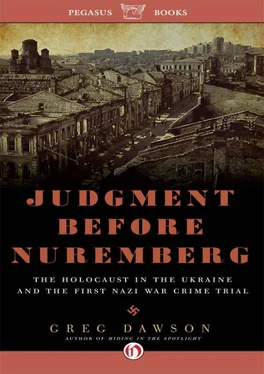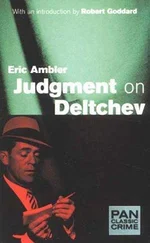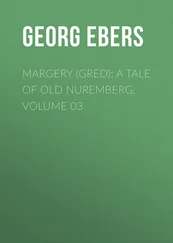And what rough beast, its hour come round at last,
Slouches towards Bethlehem to be born?
The demon impulse had been gestating for centuries in Germany since the time of Luther. Now the day was drawing near when the belly would disgorge its little prince upon the “blood-dimmed tide” of Yeats’s dystopian vision and reawaken the same devil within other lands.
The German military was guilty of more than a million counts of first-degree murder in Ukraine. But that’s a rather one-dimensional picture. A complete, 360-degree view of the havoc wreaked by Hitler’s minions must also include vandalism and armed robbery on an epic scale. Ukraine was not a mere war zone—it was the largest and most varied crime scene in history, bearing the fingerprints of an army of Charles Mansons, Sopranos, and Alex DeLarge and his marauding, nihilistic mates in A Clockwork Orange.
Hitler aimed not just to kill the Jews and enslave the rest of Ukraine’s population, he intended to eradicate their history and culture—to scrape the earth clear of Slavic fungus for the transplanting and flowering of German civilization. Eliminating the people but leaving remnants of their culture would be like chopping the tops off weeds and leaving the roots.
At Nuremberg, the assistant prosecutor for the Soviets told the court: “The Hitlerite conspirators considered culture of the mind and of humanity an obstacle to the fulfillment of their monstrous designs. In working out their insane plans for world domination, they prepared a campaign against world culture. They dreamed of turning Europe back to the days of her domination by the Huns and Teutons. Destruction of the national culture was a fundamental part of the plan for world domination established by Hitler’s conspirators. It is difficult to determine whether destruction or plunder was the more prevalent factor in these plans. But there is no disputing that both plunder and destruction were aimed at one goal—extermination—and this extermination was carried out everywhere, in all territories occupied by the Germans, on an enormous scale.”
In Hitler’s and Himmler’s vision of a colonized East, the conquered Slavic natives—whom they regarded as subhuman—would become a permanent, semi-literate servant class. These modern-day serfs would be allowed only enough education to read their names and sign documents. Over time, the memory of their once-great cultures would wither and finally die. In this way the subject Ukrainians would be like the violently deracinated Africans brought to America to become slaves, but without ever leaving their back yards. In the summer of 1942, the Nazis were well on the way to implementing this pillar of their mission in the Reichskommissariat Ukraine —six administrative districts covering most of Ukraine—second in urgency only to eradicating the Jews.
“We are like slaves,” wrote a Ukrainian woman in her diary in July 1942. “Often the book Uncle Tom’s Cabin comes to mind. Once we shed tears over those Negroes—now we ourselves are experiencing the same thing.”
This came as a bitter disappointment to the many Ukrainians, especially in the west, who had greeted the Germans as liberators and hoped that life in the Reichskommissariat Ukraine would be better than it had been under the Soviet thumb. They were quickly disabused of their fantasy. Peasants were shocked when the Nazis ordered them back to the hated collective farms they had abandoned in celebration of the invasion. The Germans engineered a famine in Kiev as part of their goal to cripple Ukrainian industry and create an exodus of city dwellers to rural areas. There were massive forced deportations to Germany. Between starvation, deportation, and shootings by Nazi authorities who ran the city like a concentration camp, the official population of Kiev shrank by 57,000 people from spring 1942 to the summer of 1943.
“Almost all Jews and Roma were killed,” historian Karel Berkhoff wrote about life in the Reichskommissariat Ukraine. “For the others, there were seemingly ceaseless daily humiliations, most notably public beatings, and a permanent sense of danger.” Nazi Ukraine was actually worse than a slave society, he noted. “Slaves, after all, were supposed to be used as servants—not to be disabled, let alone killed.” [1] Karel Berkhoff, “Hitler’s Clean Slate: Everyday Life in the Reichcommissariat Ukraine, 1941–1944” (PhD diss., University of Toronto, 1998).
The captive Ukrainians were even more dehumanized than African slaves in the Confederacy, whose owners at least understood the importance of maintaining their valuable “property.”
In December 1943, as the Nazis were retreating and the ebb tide was revealing the full, nearly unfathomable extent of their crimes, the Soviet Academy of Scientists sent a cable—really an S.O.S.—to the Faraday Society, fellow scientists in Britain. The cable described the slaughter of citizens—“beyond all effort of the imagination”—and also enumerated the systematic destruction of cultural and scientific institutions. What follows is just a small swatch from the vast tapestry of Nazi depredations in the Soviet Union as described in the cable:
“When they retreated from Smolensk, the Germans burned down the teaching, nutritional, and agricultural institutes, railway technical institutes, and the institute of telegraph and telephone communications. They blew up buildings devoted to museums, art, and history, and ruined almost all the churches—fine, old monuments of Russian architecture. In the town of Staline the Germans wrecked the medical institute and burned down all the buildings of the industrial institute where 15,000 students studied. They looted all the Kiev museums, libraries, archives, laboratories, and research institutions. Professor Alexander Brodsky, member of the Ukrainian Academy of Sciences, bears witness that the Germans blew up and burned the mining institute, with its huge library, at the University Institute of Applied Chemistry, and they looted and destroyed a number of other research institutes at Dnepropetrovsk. At Poltava, Zaporozhye, Chernigov, and other towns that have been liberated from the Germans, we found colleges, libraries, and schools destroyed.”
The British scientists responded to the plea of their beleaguered brothers with evident but ultimately impotent horror. “The Faraday Society will do its utmost to bring this to the notice of all scientists and intellectuals of the united (allied) nations, to the end that civilization shall be protected and justice meted out to the barbarians.”
The apocalyptic scale of Nazi ruination beggars the imagination; it mocks the capacity of words to make it real. Only art can express the existential truth of such carnage, as Picasso did in Guernica . If the bombing of one Spanish village could inspire abstract horror, what would Picasso have made from the rubble of a thousand villages, the ruins of a hundred libraries, the bones of a million and a half Jews?
The Nazi plundering of Mother Russia had a deeply primordial quality, like the Romans’ burning of the Great Library at Alexandria and the salting of the fields at Carthage. But unlike those ancient stories, which exist in a netherworld between fact and myth, the looting of Russia was meticulously documented—by the looters.
The Nazis formed a unit for the express purpose of conducting the plunder. Special Staff Rosenberg—under the direction of Alfred Rosenberg, Minister for Eastern Territories—was responsible for confiscating the cultural and artistic assets owned by the Soviet government (i.e., art in state museums), as well as privately held Jewish assets. Special Staff Rosenberg claimed that it surveyed and looted the contents of 2,265 museums, libraries, churches, synagogues, and university archives in the occupied Soviet territories.
Читать дальше












